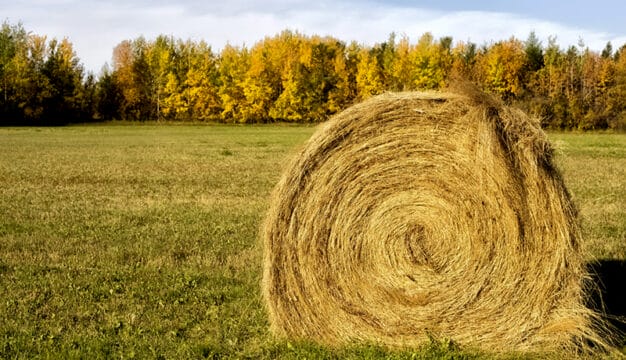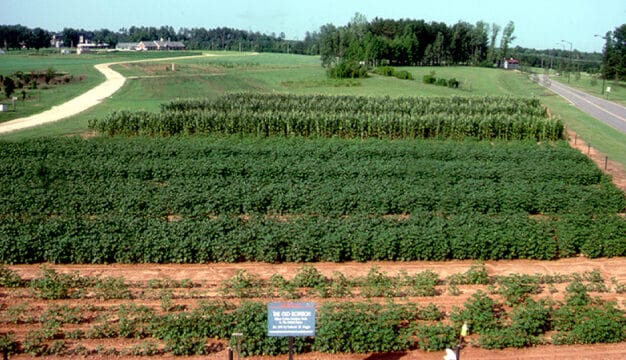Nature Conservancy in Alabama
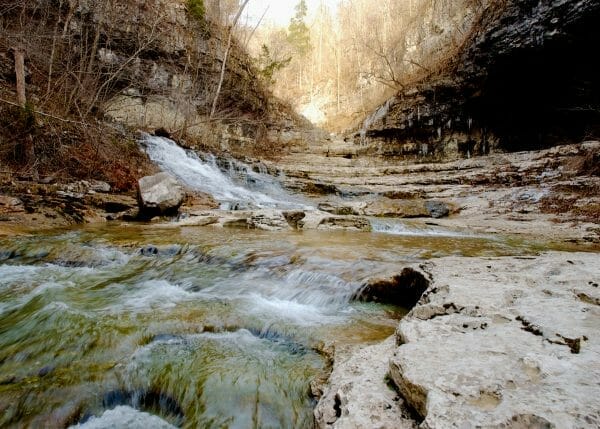 Walls of Jericho
Alabama is home to a wide array of natural areas that are managed by federal, state, and private agencies. The non-profit Nature Conservancy (TNC) has helped to protect more than 128,000 acres of environmentally significant areas in Alabama since the state chapter opened in 1989. TNC is a worldwide organization that specializes in acquiring wild lands that have significant natural or geological features or that support important wildlife or plant populations. The Nature Conservancy’s mission is to preserve the plants, animals, and natural communities that represent the diversity of life on Earth by protecting the habitats they need to survive. To achieve this goal, TNC has developed a strategic, science-based planning process, called Conservation by Design, to identify the highest-priority places.
Walls of Jericho
Alabama is home to a wide array of natural areas that are managed by federal, state, and private agencies. The non-profit Nature Conservancy (TNC) has helped to protect more than 128,000 acres of environmentally significant areas in Alabama since the state chapter opened in 1989. TNC is a worldwide organization that specializes in acquiring wild lands that have significant natural or geological features or that support important wildlife or plant populations. The Nature Conservancy’s mission is to preserve the plants, animals, and natural communities that represent the diversity of life on Earth by protecting the habitats they need to survive. To achieve this goal, TNC has developed a strategic, science-based planning process, called Conservation by Design, to identify the highest-priority places.
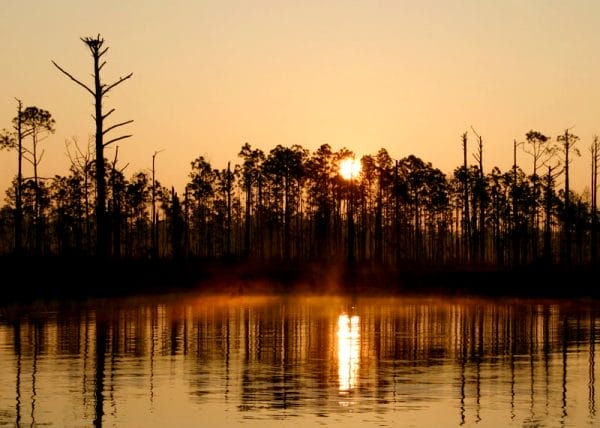 Bon Secour National Wildlife Refuge
In many cases, TNC provides funds to donors and members for the initial acquisition of the land and then turns the land over to the state or federal government, either through an outright property transfer or through a subsequent sale. In Alabama, much of the land that is encompassed in what are now the Walls of Jericho, Bon Secour National Wildlife Refuge, and Cahaba River National Wildlife Refuge was originally acquired by the Nature Conservancy. Most of the land acquired through the efforts of TNC have been transferred to the state of Alabama or to the federal government, but TNC owns and manages 16 sites. These sites represent varied and distinct natural areas in Alabama across the state. The preserves range from the foothills of northern Alabama to the beaches of the Gulf Coast and run the gamut from leafy glades that host rare plants to caves harboring endangered bats. Public access to many of the preserves is limited because of their fragile nature.
Bon Secour National Wildlife Refuge
In many cases, TNC provides funds to donors and members for the initial acquisition of the land and then turns the land over to the state or federal government, either through an outright property transfer or through a subsequent sale. In Alabama, much of the land that is encompassed in what are now the Walls of Jericho, Bon Secour National Wildlife Refuge, and Cahaba River National Wildlife Refuge was originally acquired by the Nature Conservancy. Most of the land acquired through the efforts of TNC have been transferred to the state of Alabama or to the federal government, but TNC owns and manages 16 sites. These sites represent varied and distinct natural areas in Alabama across the state. The preserves range from the foothills of northern Alabama to the beaches of the Gulf Coast and run the gamut from leafy glades that host rare plants to caves harboring endangered bats. Public access to many of the preserves is limited because of their fragile nature.
Nature Conservancy Preserves
Barton’s Beach on the Cahaba Preserve in Perry County encompasses 125 acres of Deep South wetland, with tupelo, river birch, and towering bald cypress trees festooned in Spanish moss. The preserve, acquired in 2000, boasts profuse hardwood forests and sandbars. The beach itself is actually a large sandbar that is a nesting site for turtles.
Brasher Woods Preserve in Etowah County is an 80-acre old-growth hardwood forest obtained in 1995. It is home to a variety of wildlife, including white-tail deer and migratory songbirds.
Cahaba River Landscape Conservation Area is a patchwork of tracts that have been acquired or are managed in partnership in an effort to preserve the unique and important habitats of the Cahaba River watershed. So far, the Nature Conservancy has made agreements or acquisitions to protect more than 3,800 acres. The Pratt’s Ferry, Bibb County Glades, and Barton’s Beach Preserves all lie within this larger conservation area.
Chitwood Barrens Preserve in DeKalb County was initially purchased in 1985 to preserve the extremely rare green pitcher plant (Sarracenia oreophila), a federally listed endangered species. Its 53 acres protect other rare plants, including the longleaf sunflower and the Little River Canyon onion, which have extremely limited ranges.
Coosa Bog Preserve, in Cherokee County, was acquired in 1989. This tiny preserve, just 3.3 acres, is home to a large colony of green pitcher plants.
Dennis Cove Preserve was the first Alabama acquisition for the Nature Conservancy in 1981. It is a 159-acre area of bayous, tidal flats, and marsh along the mouth of Fowl River in southern Mobile County near the southern tip of Mon Louis Island. The flats and marshes sustain a variety of shorebirds and waterfowl, including ospreys, American egrets, brown pelicans, green herons, and great blue herons.
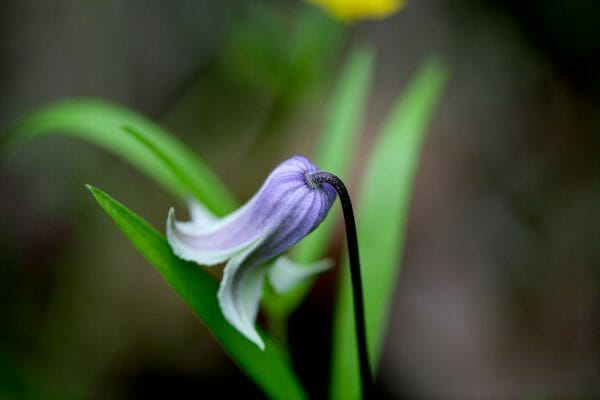 Alabama Leather Flower
Dry Creek Preserve, acquired in 1986, is a 26-acre stretch of hardwood forest along the banks of Dry Creek in St. Clair County. It harbors one of only seven known populations of the endangered Alabama leather flower (Clematis socialis), which grows only in Alabama and Georgia. Although the site is relatively small at 31 acres, it supports migratory songbirds and a local beaver colony.
Alabama Leather Flower
Dry Creek Preserve, acquired in 1986, is a 26-acre stretch of hardwood forest along the banks of Dry Creek in St. Clair County. It harbors one of only seven known populations of the endangered Alabama leather flower (Clematis socialis), which grows only in Alabama and Georgia. Although the site is relatively small at 31 acres, it supports migratory songbirds and a local beaver colony.
Grand Bay Savannah Landscape encompasses 5,442 total acres of tracts that preserve a variety of coastal ecosystems, including marsh, maritime forest and flatwoods, and upland wetlands. It is a prime location for biologists studying the life cycle of the yellow rail, a small marsh bird.
Gulf Creek Canyon Preserve, in St. Clair County near the private Horse Pens 40 nature park, sits high on a mountain overlooking central Alabama. Obtained in 1999, the preserve is split by Gulf Creek, which drains through a gorge several hundred feet deep. The 125 acres include an impressive array of vertical cliffs, a tumbling creek, and seasonal waterfalls. The upper reaches are covered with thick hardwood forests.
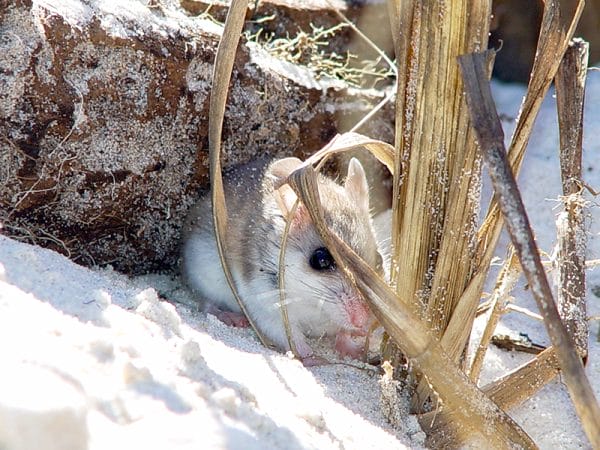 Alabama Beach Mouse
Gulf Islands Landscape Conservation Area encompasses part of the Gulf of Mexico and much of the southern coast of Alabama and preserves maritime live oak forest, wet longleaf pine savanna, freshwater marsh, and small-stream swamp forest. Tracts within the conservation area protect some 13 rare plant species, including the white-topped pitcher plant, Chapman’s butterwort, and large-leaved jointweed. Protected animals include gopher tortoises, eastern diamondback rattlesnake, and red-cockaded woodpeckers. The Nature Conservancy is working with state and private organizations to develop habitat for the Alabama beach mouse and neotropical migratory birds. The conservancy wholly owns Rabbit Island within the conservation area.
Alabama Beach Mouse
Gulf Islands Landscape Conservation Area encompasses part of the Gulf of Mexico and much of the southern coast of Alabama and preserves maritime live oak forest, wet longleaf pine savanna, freshwater marsh, and small-stream swamp forest. Tracts within the conservation area protect some 13 rare plant species, including the white-topped pitcher plant, Chapman’s butterwort, and large-leaved jointweed. Protected animals include gopher tortoises, eastern diamondback rattlesnake, and red-cockaded woodpeckers. The Nature Conservancy is working with state and private organizations to develop habitat for the Alabama beach mouse and neotropical migratory birds. The conservancy wholly owns Rabbit Island within the conservation area.
Kathy Stiles Freeland Bibb County Glades Preserve, also along the Cahaba River, was acquired in 1997 to protect a large variety of rare plants, eight of which are new to science and one—the dwarf horse nettle (Solanum pumilum)—had not been found since the 1830s and was believed to be extinct until its discovery here in 1993. Sixty-one rare plant species have been found on the preserve’s 480 acres. The Little Cahaba River flows through the preserve, and the remains of Brighthope Furnace, Alabama’s earliest known ironworks, are hidden in the thick forest.
Keel Mountain Preserve was acquired in 2001 to protect the Morefield’s leather flower (Clematis morefieldii), an endangered plant found only in the immediate area. The preserve also encompasses steep rock cliffs, sinkholes, a sparkling creek, and a thick forest of oak, hickory, and pine. One particularly notable sinkhole, dubbed “Lost Sink,” features a waterfall that disappears into its depths. The 310-acre preserve near Huntsville, Madison County, is home to numerous migratory songbirds and a large population of whitetail deer. It is associated with the 460-square-mile Paint Rock River Landscape Conservation Area, which is home to the Walls of Jericho natural feature.
Lower Perdido Islands Preserve conserves Bird, Robinson, and Walker Islands in the Gulf of Mexico off the city of Orange Beach, Baldwin County. These islands are home to a wide variety of shorebirds and other wildlife and are increasingly threatened by human traffic from boating. The surrounding areas are also a significant home for young marine creatures, including crabs, shrimp, and various popular game fish. TNC is working with local officials and groups to manage human encroachment on these islands.
Mobile Tensaw Delta Landscape Conservation Area encompasses 55,000 acres of water and land in the Mobile-Tensaw Delta that is home to 67 threatened or endangered species. TNC donated $1 million dollars, the Alabama chapter donated $940,000, and Ducks Unlimited donated $250,000 to purchase the original 47,000 acres. In 2024, the Nature Conservancy partnered with outdoor-gear manufacturer Patagonia and an anonymous donor to purchase 8,000 additional acres of land at the headwaters of the Mobile-Tensaw Delta. The site is managed as part of the Forever Wild program.
Prairie Grove Glades, acquired in 1995, is the largest intact glade left in Alabama and is a haven for a dozen species of rare plants. A glade is defined as a small open area of naturally occurring vegetation. Most Alabama glades have been bulldozed or paved. The preserve’s 191 acres in western Alabama near Moulton, Lawrence County, are a patchwork of open rocky areas covered with rare flowering plants, such as Harper’s umbrella plant (Eriogonum longifolium var. harperi) and the Alabama larkspur (Delphinium alabamicum), and shaded groves of hardwoods and cedar trees.
Pratt’s Ferry Preserve, on the south bank of the Cahaba River in Bibb County, was obtained in 1991. The preserve is only 12 acres but protects several rare wildflowers. One resident shrub, the Alabama croton (Croton alabamensis), is only found in the Cahaba River and Black Warrior River watersheds.
Rabbit Island is a 26-acre coastal marsh island, many of which are rapidly disappearing as a result of extensive coastal development. Located near Ono Island in Baldwin County, the island remains a wild and natural habitat for marsh rabbits, water snakes, and diamondback terrapins, and is also an important site for migrating shorebirds. The island was acquired in 1997.
Roberta Case Pine Hills Preserve was established in 1999 in Autauga County as a haven for one of the largest populations of the federally endangered Alabama canebrake pitcher plant (Sarracenia alabamensis), which is found nowhere else in the world. The preserve’s 400 acres are home to a number of colonies of the plant, which thrives in seepages scattered among the longleaf pine forest that dominates the preserve.
Roy B. Whitaker Preserve,
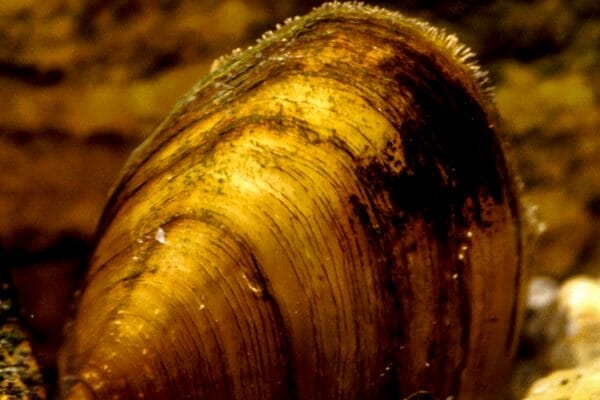 Pale Lilliput Mussel
on the banks of the Paint Rock River in Jackson County, consists of open fields and river bottomlands that host a lush community of hardwoods. Acquired in 2005, the preserve covers 323 acres with more than 1.5 miles of Paint Rock River frontage. The Whitaker preserve is a key link in one of TNC’s major efforts in Alabama: preserving and restoring as much of the Paint Rock River watershed as possible. The river and its major tributaries provide critical habitat for migratory songbirds as well as three rare species of fish, and 12 rare mussel species, including the pale lilliput (Toxolasma cylindrellus) and the Alabama lampshell (Lampsilis virescens), which are found nowhere else in the world.
Pale Lilliput Mussel
on the banks of the Paint Rock River in Jackson County, consists of open fields and river bottomlands that host a lush community of hardwoods. Acquired in 2005, the preserve covers 323 acres with more than 1.5 miles of Paint Rock River frontage. The Whitaker preserve is a key link in one of TNC’s major efforts in Alabama: preserving and restoring as much of the Paint Rock River watershed as possible. The river and its major tributaries provide critical habitat for migratory songbirds as well as three rare species of fish, and 12 rare mussel species, including the pale lilliput (Toxolasma cylindrellus) and the Alabama lampshell (Lampsilis virescens), which are found nowhere else in the world.
Sharp-Bingham Preserve in Jackson County was originally purchased in 2004 and more than doubled in size with an additional land purchase in 2007. It is the largest of the Nature Conservancy’s preserves in Alabama at 2,850 acres. It contains an extensive cave system, with 30 caves identified and perhaps miles of linkages waiting to be discovered. The cave system also hosts a resident population of the Tennessee cave salamander (Gyrinophilus palleucus) and occasional bat populations.
Splinter Hill Bog Preserve, in northern Baldwin County, is a refuge for rare animals such as Bachmann’s sparrow (Peucaea aestivalis), the Florida pine snake (Pituophis melanoleucus), endangered gopher tortoises (Gopherus polyphemus), and numerous rare plant species, including a dozen types of carnivorous plants. Acquired in 2004, the preserve has expanded to include more than 2,000 acres, owned by the Conservancy and the State of Alabama, that provide diverse habitats ranging from longleaf pine forests to swamps and rivers. The preserve is also an important stopover site for migratory songbirds.
Weeks Bay National Estuarine Research Reserve is located on the eastern shore of Mobile Bay near the town of Fairhope, Baldwin County. It encompasses 6,525 acres of water, marshland, estuary, and forested wetlands. It is critical habitat for spawning fish and shellfish as well as many species of birds and mammals. It plays host to a major research center and is part of the National Estuarine Research Reserve System (NERRS), a nationwide network of 29 coastal reserves managed for long-term research and education and interpretative programs on estuarine habitats.
